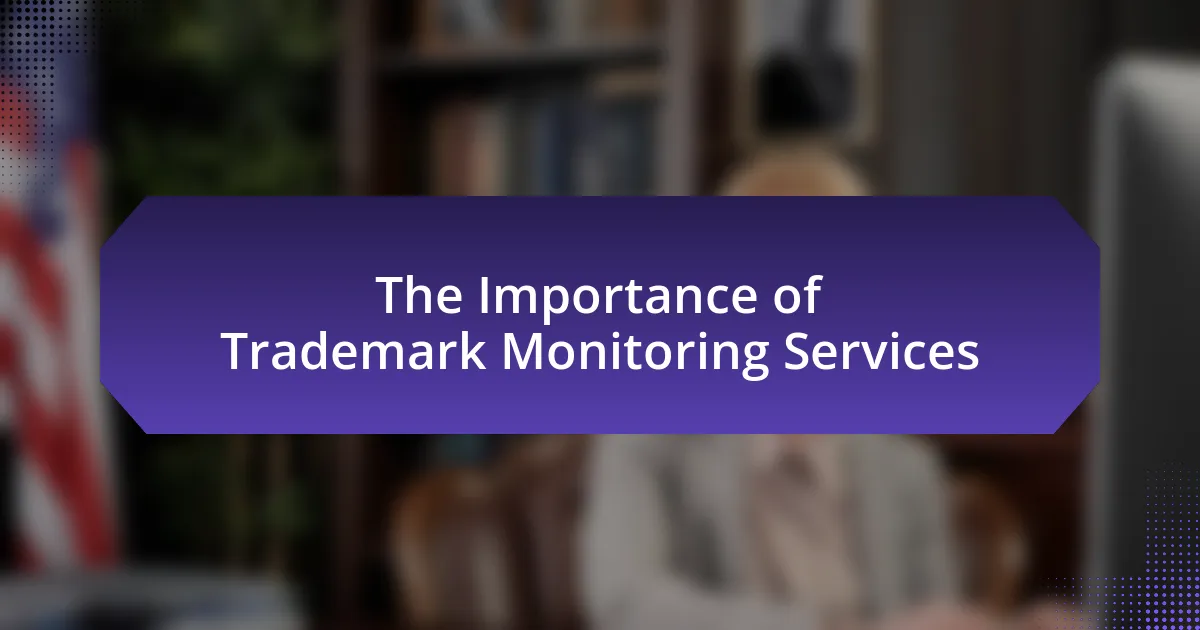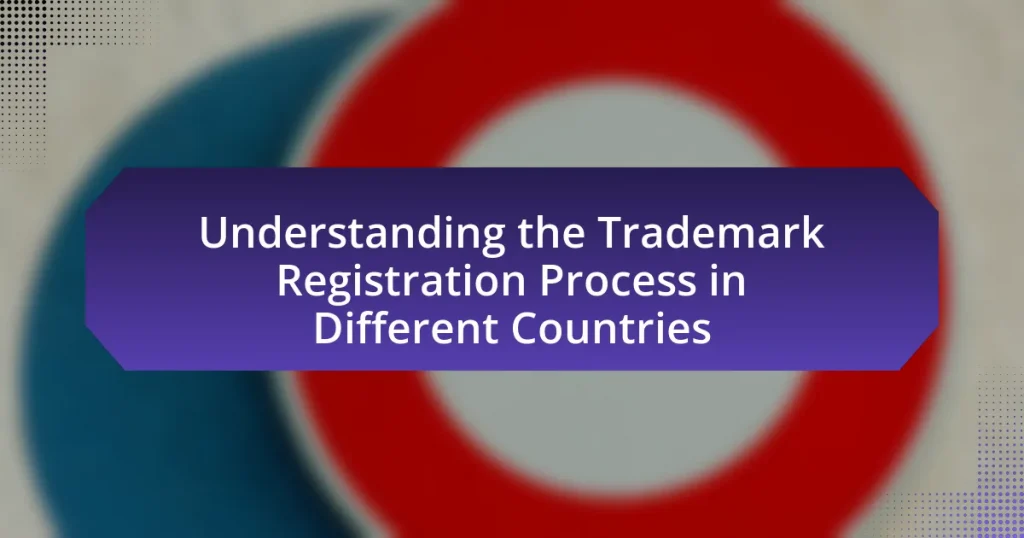Trademark monitoring services are essential tools for businesses to protect their registered trademarks from unauthorized use and potential infringements. These services continuously track trademarks across various platforms, including online marketplaces and social media, utilizing automated tools to identify violations and alert trademark owners. The article outlines the processes involved in trademark monitoring, the risks businesses face without these services, and the key benefits they provide, such as early detection of infringements and the ability to take timely legal action. Additionally, it discusses the cost implications, factors influencing pricing, and best practices for effectively integrating trademark monitoring into a company’s overall strategy.
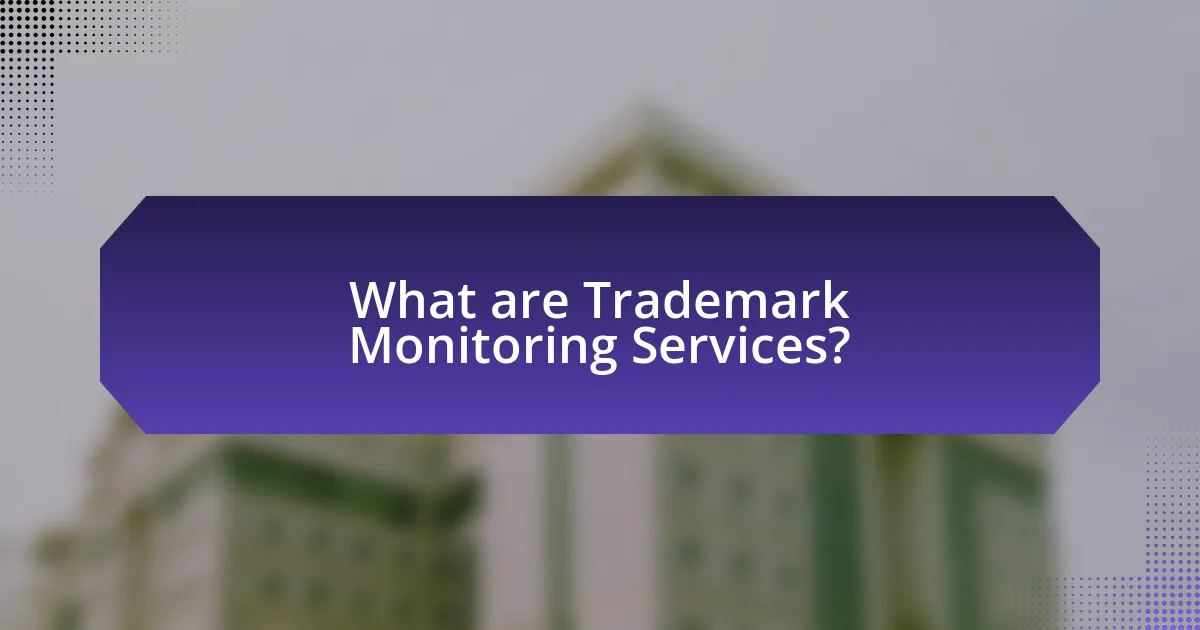
What are Trademark Monitoring Services?
Trademark monitoring services are specialized services that track the use of registered trademarks to identify potential infringements or unauthorized uses. These services help businesses protect their intellectual property by monitoring various platforms, including online marketplaces, social media, and trademark registries, for any instances of similar or identical marks being used without permission. By providing timely alerts about potential violations, trademark monitoring services enable companies to take appropriate legal action to safeguard their brand and maintain their market position.
How do Trademark Monitoring Services function?
Trademark monitoring services function by continuously tracking the use of registered trademarks across various platforms, including online marketplaces, social media, and trademark databases. These services utilize automated tools and algorithms to identify potential infringements or unauthorized uses of trademarks, alerting the trademark owner to any violations. For instance, according to a report by the International Trademark Association, effective monitoring can help businesses protect their brand identity and prevent dilution, as 70% of trademark owners reported that they faced infringement issues. This proactive approach enables companies to take timely legal action against infringers, safeguarding their intellectual property rights.
What processes are involved in Trademark Monitoring Services?
Trademark monitoring services involve several key processes: trademark search, monitoring, analysis, and enforcement. Initially, trademark search identifies existing trademarks that may conflict with a client’s mark. Monitoring continuously tracks new trademark applications and registrations to detect potential infringements. Analysis evaluates the significance of any identified conflicts, assessing the risk to the client’s brand. Finally, enforcement involves taking legal action against infringers to protect the trademark rights. These processes are essential for maintaining brand integrity and preventing unauthorized use, as evidenced by the increasing number of trademark disputes in various industries.
How do these processes ensure trademark protection?
Trademark monitoring services ensure trademark protection by actively tracking the use of registered trademarks and identifying potential infringements. These services utilize automated systems and legal expertise to monitor various platforms, including online marketplaces and social media, for unauthorized use of trademarks. By promptly detecting violations, trademark owners can take necessary legal actions to enforce their rights, thereby maintaining the distinctiveness and value of their trademarks. Studies indicate that proactive monitoring can reduce the risk of brand dilution and unauthorized competition, reinforcing the importance of these processes in safeguarding intellectual property.
Why are Trademark Monitoring Services essential for businesses?
Trademark monitoring services are essential for businesses because they help protect brand identity and prevent unauthorized use of trademarks. By continuously tracking new trademark applications and registrations, these services enable companies to identify potential infringements early, allowing them to take timely legal action. According to the United States Patent and Trademark Office, over 700,000 trademark applications were filed in 2020 alone, highlighting the increasing competition and risk of brand dilution. Effective monitoring can thus safeguard a business’s reputation and market position, ensuring that its intellectual property remains distinct and legally protected.
What risks do businesses face without Trademark Monitoring Services?
Businesses face significant risks without Trademark Monitoring Services, including potential brand dilution, loss of market share, and increased legal costs. Without monitoring, companies may not detect unauthorized use of their trademarks, leading to consumer confusion and weakened brand identity. A study by the International Trademark Association indicates that 75% of businesses experience trademark infringement, which can result in costly litigation and damage to reputation. Additionally, failure to act against infringements can lead to the loss of trademark rights, as non-use can result in abandonment claims. Thus, the absence of monitoring services exposes businesses to substantial financial and reputational threats.
How can Trademark Monitoring Services mitigate these risks?
Trademark monitoring services mitigate risks by continuously tracking the use of trademarks across various platforms and jurisdictions. These services identify potential infringements, such as unauthorized use or similar trademarks that could confuse consumers. By providing timely alerts, trademark monitoring enables businesses to take swift legal action, thereby protecting their brand reputation and market position. According to a study by the International Trademark Association, proactive monitoring can reduce the likelihood of costly litigation by up to 30%, demonstrating the effectiveness of these services in safeguarding intellectual property.
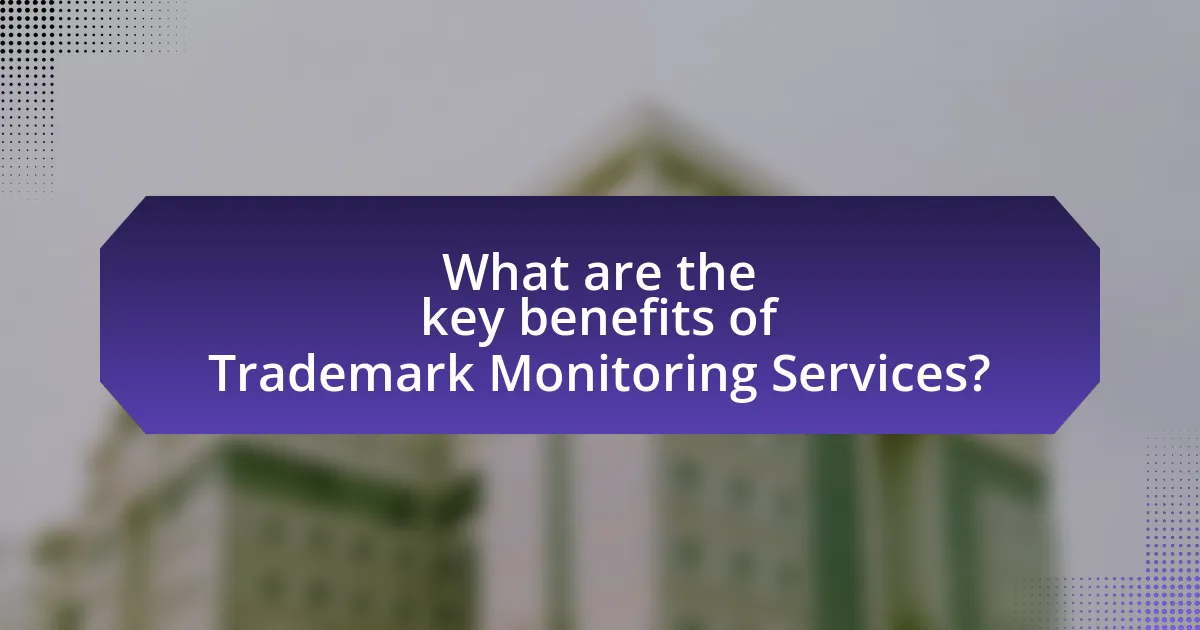
What are the key benefits of Trademark Monitoring Services?
Trademark monitoring services provide essential benefits, including the protection of brand identity, early detection of potential infringements, and the ability to take timely legal action. These services help businesses safeguard their trademarks by continuously monitoring for unauthorized use, which can lead to brand dilution or consumer confusion. According to a study by the International Trademark Association, companies that actively monitor their trademarks are 50% more likely to successfully enforce their rights compared to those that do not. This proactive approach not only preserves brand integrity but also enhances overall market competitiveness.
How do Trademark Monitoring Services enhance brand protection?
Trademark monitoring services enhance brand protection by actively tracking the use of trademarks across various platforms and jurisdictions. These services identify potential infringements, such as unauthorized use or similar trademarks that could confuse consumers. By providing timely alerts about these infringements, trademark monitoring allows businesses to take swift legal action, thereby safeguarding their brand reputation and market position. According to a study by the International Trademark Association, companies that utilize monitoring services report a 30% reduction in trademark infringement incidents, demonstrating the effectiveness of these services in maintaining brand integrity.
What specific threats do these services help identify?
Trademark monitoring services help identify specific threats such as trademark infringement, counterfeiting, brand dilution, and unauthorized use of trademarks. These services actively track new trademark applications and registrations, alerting businesses to potential conflicts that could harm their brand integrity. For instance, a study by the International Trademark Association found that 75% of companies reported experiencing trademark infringement, underscoring the necessity of monitoring services to protect intellectual property effectively.
How do they assist in maintaining brand reputation?
Trademark monitoring services assist in maintaining brand reputation by actively tracking and identifying unauthorized use of trademarks. These services help brands protect their intellectual property, ensuring that any infringement is detected early, which prevents potential damage to the brand’s image and consumer trust. For instance, a study by the International Trademark Association found that 75% of companies reported that trademark infringement negatively impacted their brand reputation. By addressing these infringements promptly, trademark monitoring services safeguard the integrity of the brand and reinforce consumer confidence.
What cost implications are associated with Trademark Monitoring Services?
Trademark monitoring services typically incur costs that can range from a few hundred to several thousand dollars annually, depending on the scope of monitoring and the number of trademarks involved. These services often charge based on the number of classes of goods or services monitored, the frequency of monitoring, and the geographical regions covered. For instance, comprehensive monitoring that includes global coverage and multiple classes can significantly increase costs. Additionally, businesses may face indirect costs related to potential legal actions if infringements are detected, which can include litigation expenses and settlement fees. Therefore, while the upfront costs of trademark monitoring services can vary, the potential financial implications of not monitoring trademarks can be far greater, as they may lead to loss of brand value and market share.
How do these services compare to potential losses from trademark infringement?
Trademark monitoring services significantly reduce potential losses from trademark infringement by proactively identifying unauthorized use of trademarks. These services help businesses maintain brand integrity and prevent revenue loss, as the average cost of trademark infringement litigation can exceed $1 million, according to the American Bar Association. By investing in monitoring services, companies can mitigate risks associated with infringement, such as lost sales, diminished brand reputation, and legal expenses, ultimately protecting their market position and financial interests.
What factors influence the pricing of Trademark Monitoring Services?
The pricing of Trademark Monitoring Services is influenced by several key factors, including the scope of monitoring, the frequency of reports, the geographical coverage, and the level of customization required. The scope of monitoring refers to the number of trademarks being tracked; more trademarks typically lead to higher costs. The frequency of reports, whether daily, weekly, or monthly, also affects pricing, as more frequent updates require more resources. Geographical coverage impacts costs as monitoring trademarks in multiple jurisdictions increases complexity and expense. Lastly, the level of customization, such as tailored alerts or specific reporting formats, can further drive up the price, as customized services often require additional labor and expertise.
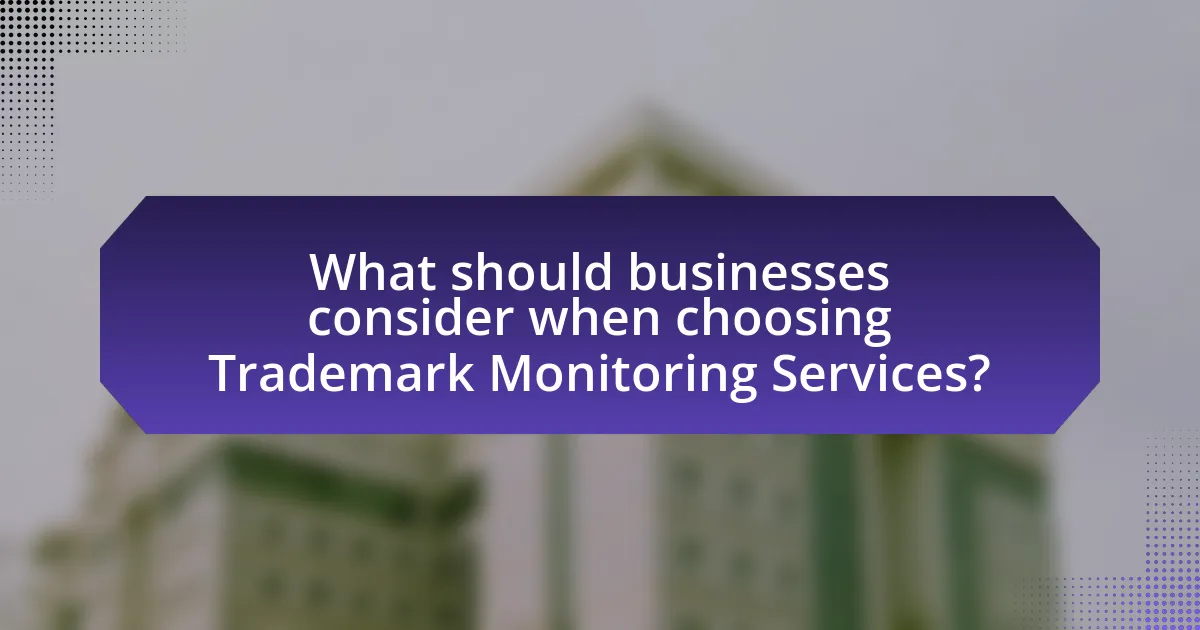
What should businesses consider when choosing Trademark Monitoring Services?
Businesses should consider the scope of coverage, the technology used, and the service provider’s reputation when choosing Trademark Monitoring Services. A comprehensive scope ensures that all relevant markets and jurisdictions are monitored, which is crucial for identifying potential infringements. Advanced technology, such as AI-driven algorithms, enhances the accuracy and efficiency of monitoring, allowing for quicker detection of unauthorized use. Additionally, a reputable service provider with a proven track record can offer insights and support that are vital for effective trademark protection. According to a study by the International Trademark Association, businesses that actively monitor their trademarks are 30% more likely to successfully enforce their rights compared to those that do not.
What features are essential in effective Trademark Monitoring Services?
Effective Trademark Monitoring Services must include comprehensive search capabilities, real-time alerts, and detailed reporting. Comprehensive search capabilities allow for the identification of potential infringements across various platforms, including online marketplaces and social media. Real-time alerts ensure that trademark owners are promptly notified of any unauthorized use, enabling swift action to protect their rights. Detailed reporting provides insights into monitoring activities, infringement trends, and potential risks, which aids in strategic decision-making. These features collectively enhance the effectiveness of trademark monitoring by ensuring timely detection and response to potential threats.
How does the technology used impact service effectiveness?
The technology used significantly impacts service effectiveness by enhancing the speed, accuracy, and scalability of trademark monitoring services. Advanced algorithms and machine learning enable real-time tracking of trademark infringements, allowing for immediate responses to potential violations. For instance, a study by the World Intellectual Property Organization (WIPO) found that automated monitoring systems can reduce the time spent on manual searches by up to 80%, thereby increasing operational efficiency. Furthermore, data analytics tools provide insights into market trends and competitor activities, which can inform strategic decisions and improve overall service delivery.
What level of customer support should businesses expect?
Businesses should expect a high level of customer support when utilizing trademark monitoring services. This support typically includes timely responses to inquiries, proactive communication regarding potential trademark infringements, and personalized assistance tailored to the specific needs of the business. According to a survey by the International Trademark Association, 78% of businesses reported that effective customer support significantly enhances their experience with trademark monitoring services, indicating that responsive and knowledgeable support is crucial for navigating complex trademark issues.
How can businesses evaluate the effectiveness of Trademark Monitoring Services?
Businesses can evaluate the effectiveness of Trademark Monitoring Services by assessing the frequency and relevance of alerts received regarding potential infringements. A high volume of relevant alerts indicates that the monitoring service is effectively tracking potential trademark violations, while a low volume may suggest inadequate coverage. Additionally, businesses should analyze the resolution rate of reported infringements, as a higher resolution rate demonstrates the service’s ability to facilitate action against violations. According to a study by the International Trademark Association, companies that actively monitor their trademarks report a 30% increase in successful enforcement actions, highlighting the importance of effective monitoring services in protecting brand integrity.
What metrics should be used to measure success?
To measure success in trademark monitoring services, key metrics include the number of potential infringements identified, the speed of response to these infringements, and the effectiveness of enforcement actions taken. Tracking the number of infringements allows businesses to assess the level of risk to their trademarks, while measuring response time indicates the efficiency of the monitoring service. Additionally, evaluating the outcomes of enforcement actions, such as settlements or court victories, provides insight into the effectiveness of the monitoring strategy. These metrics collectively offer a comprehensive view of the success of trademark monitoring efforts.
How often should businesses review their monitoring strategies?
Businesses should review their monitoring strategies at least annually. Regular annual reviews allow companies to assess the effectiveness of their monitoring efforts, adapt to changes in the market, and ensure compliance with evolving regulations. According to a study by the International Trademark Association, 70% of businesses that conduct annual reviews report improved trademark protection and risk management. This frequency helps businesses stay proactive in identifying potential infringements and adjusting their strategies accordingly.
What are best practices for utilizing Trademark Monitoring Services?
Best practices for utilizing Trademark Monitoring Services include regularly reviewing monitoring reports, setting clear objectives for monitoring, and promptly addressing potential infringements. Regularly reviewing reports ensures that businesses stay informed about new applications or uses that may conflict with their trademarks. Setting clear objectives helps in focusing monitoring efforts on specific markets or competitors, enhancing the effectiveness of the service. Promptly addressing potential infringements is crucial, as timely action can prevent further unauthorized use and protect brand integrity. According to the International Trademark Association, proactive monitoring can significantly reduce the risk of brand dilution and legal disputes.
How can businesses integrate these services into their overall strategy?
Businesses can integrate trademark monitoring services into their overall strategy by aligning these services with their brand protection and competitive analysis efforts. By actively monitoring trademarks, businesses can identify potential infringements and take timely action to protect their intellectual property, which is crucial for maintaining brand integrity and market position. Research indicates that companies that implement proactive trademark monitoring can reduce the risk of costly legal disputes by up to 30%, thereby safeguarding their revenue and reputation. This integration not only enhances legal compliance but also informs marketing strategies by providing insights into competitor activities and market trends.
What common mistakes should businesses avoid when using these services?
Businesses should avoid neglecting regular monitoring of their trademarks, as this can lead to unaddressed infringements and potential loss of brand value. Failing to set clear objectives for trademark monitoring can result in ineffective use of resources and missed opportunities for enforcement. Additionally, businesses should not underestimate the importance of timely responses to potential infringements; delays can weaken legal standing and allow competitors to capitalize on brand confusion. Lastly, relying solely on automated services without human oversight can lead to missed nuances in trademark usage, which may require expert interpretation.
